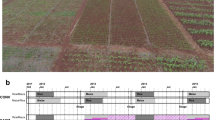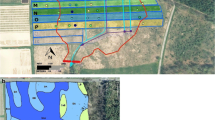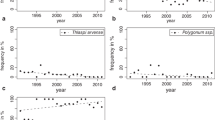Abstract
G. sepium and C. spectabilis hedgerows were established on slopes ranging from 18 to 31% in an effort to reduce soil erosion and improve upland rice and maize production. Upland rice and maize responded more to soil incorporated G. sepium biomass than to mulched, C. spectibilis. Incorporating hedgerow biomass equivalent to over 40 kg N per hectare, however, did not increase upland rice productivity. Maize, planted during the drought-prone second season, responded more than did rice to mulching. Crop performance improved along the slope gradient. Hedgerow-crop competition was observed at the upper and lower interfaces. Terracing intensified hedgerow-crop competition at the upper interface by reducing the crop's effective rooting depth. Under prevailing climatic and soil conditions, mixed hedgerows of C. spectabilis and G. sepium initially produced approximately 7 tons of fresh biomass per hectare every 3 months. Four years after hedgerow establihment, however C. spectabilis biomass was chlorotic and considerable mortality was observed, suggesting that C. spectabilis may be depleting soil N reserves.
Similar content being viewed by others
References
Allen ON and Allen EK (1981) The Leguminosae. University of Wisconsin Press, Madison
Arraudeau M and Harahap Z (1986) Relevant upland rice breeding objectives. In: Progress in Upland Rice Research. International Rice Research Institute, Los Baños, Philippines
Bohn H, McNeal B and O'Connor G (1985) Soil Chemistry, 2nd ed. John Wiley & Sons, New York
Bureau of Soils, Philippines (1985) Detailed reconnaissance soils survey, suitability, classification; Claveria complementation project, Claveria, Misamis Oriental, Manila, Bureau of Soils
Celestino AP (1985) Ipil-ipil hedgerows for soil erosion control in hillylands. Farming Systems and Soil Resources Institute, College of Agriculture, University of the Philippines at Los Baños Philippines
Fujisaka S (1989) A method for farmer-participatory research and technology transfer: upland soil conservation in the Philippines. Expl Agric 25: 423–433
Gupta PC and O'Toole JC (1986) Upland Rice — A Global Perspective. The International Rice Research Institute (IRRI), Los Baños, Philippines
Holland EA and Coleman DC (1987) Litter placement effects on microbial and organic matter dynamics in an agroecosystem. Ecology 68: 425–433
Huxley PA (1986) Rationalizing research on hedgerow intercropping: an overview. Working paper no. 40. International Council for Research in Agroforestry, Nairobi, Kenya
IRRI (International Rice Research Institute) (1989) Annual Report for 1988, p 236. Los Baños, Philippines
IRRI (International Rice Research Institute) (1988) Annual Report for 1987, pp 442–445 Los Baños, Philippines
IRRI (International Rice Research Institute) (1987) Annual Report for 1986, p 444. Los Baños, Philippines
IRRI (International Rice Research Institute) (1985) Annual Report for 1984, pp 374–376. Los Baños, Philippines
Juo ASR and Sanchez PA (1986) Soil nutritional aspects with a view to characterize upland rice environments. In: Progress in Upland Rice Research, pp 85–91. The International Rice Research Institute (IRRI), Los Baños, Philippines
Kang BT, Wilson GR and Lawson TL (1984) Alley cropping: a stable alternative to shifting cultivation. International Institute of Tropical Agriculture, Ibadan, Nigeria
Kang BT and Duguma B (1985) Nitrogen management in alley cropping systems. In: Kang BT and van der Heide J, eds, Nitrogen Management in Farming Systems in Humid and Subhumid Tropics. Institute for Soil Fertility (IB) Haren, The Netherlands and International Institute of Tropical Agriculture (IITA),Ibadan, Nigeria
Kubota T, Verakpatananirund P, Piyapongse P and Phetchawee S (1982) Improvement of the moisture regime of uplands soils by soil management. In: Proceedings of the International Symposium on Distribution, Characteristics, and Utilization of Problem Soils. Japanese Society of Soil Science and Plant Nutrition. Tropical Agricultural Research Series No 15
Ladha JD, Peoples MB, Garrity DP, Capuno VT and Dart PJ (1992) Measurement of N2 fixation of hedgerow vegetation in an alley-crop system using the 15N natural abundance method. Soil Science Society, American Proceedings (in press)
Lal R (1989a) Agroforestry systems and soil surface management of tropical alfisol: II. Water runoff, soil erosion, and nutrient loss. Agroforestry Systems 8: 97–111
MacLean RH, Litsinger JA, Moody K and Watson AK (1992) Increasing Gliricidia sepium and Cassia spectabilis biomass production. Agroforestry Systems (in press)
Magbanua RD and Garrity DP (1988) Acid upland agroecosystems: a microlevel analysis of the Claveria research site. In: Proceedings of the Acid Upland Research Design Workshop for Clateria Site. International Rice Research Institute
Nye PH and Greenland DJ (1960) The Soils under Shifting Cultivation. Harpenden, Commonwealth Agriculture Bureau
Parish DH (1975) Effects of compaction on nutrient supply to plants. In: Compaction of Agricultural Soils. American Society of Agricultural Engineers, St. Joseph, Michigan
Russel EW (1973) Soil Conditions and Plant Growth, 10th ed. Longman, London
SAS (1988) SAS/STAT User's Guide Release 6.03 Edition SAS Institute Inc, Cary, NC
Schnitzer M (1986) Binding of humic substances by soil mineral colloids. In: Interaction of Soil Minerals with Natural Organics and Microbes, pp 77–101. Soil Science Society of America Spec Pub no 17
Turner AK, McMahon TA and Srikanthan R (1984) Rainfall intensity and overland flow in relation to soil erosion studies for tropical lands. In: Craswell ET, Remenyi JV, and Nallana LG, eds, Soil Erosion Management, pp 24–31. Proceedings of a workshop held PCARRD, Los Baños, Philippines, ACIAR Proc No 6
Yamoah CF and Burleigh JR (1988) Alley cropping Sesbania sesban (L) Merill with food crops in the highland region of Rwanda. Agroforestry systems 10: 169–181
Yamoah CF, Agboola AA and Wilson GF (1986) Nutrient contribution and maize performance in alley cropping systems. Agroforestry systems 4: 247–254
Author information
Authors and Affiliations
Rights and permissions
About this article
Cite this article
Maclean, R.H., Litsinger, J.A., Moody, K. et al. The impact of alley cropping Gliricidia sepium and Cassia spectabilis on upland rice and maize production. Agroforest Syst 20, 213–228 (1992). https://doi.org/10.1007/BF00053140
Issue Date:
DOI: https://doi.org/10.1007/BF00053140




